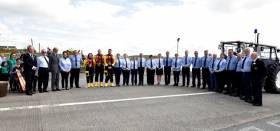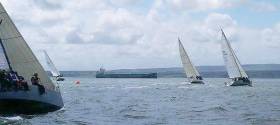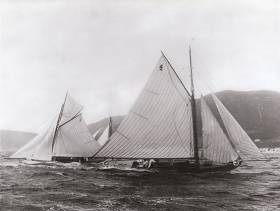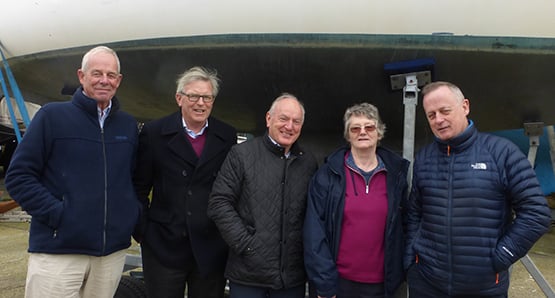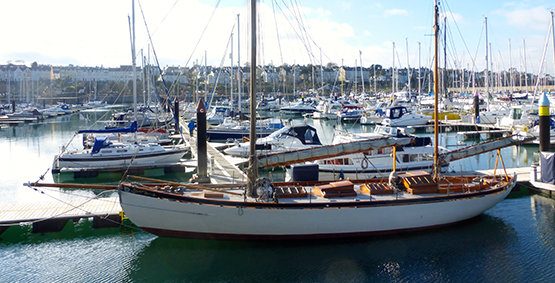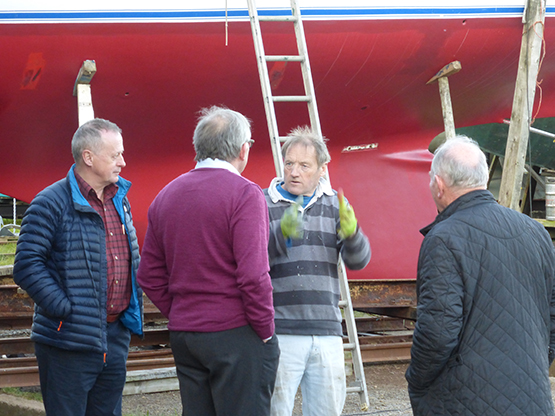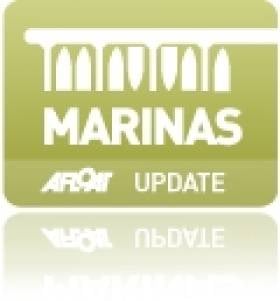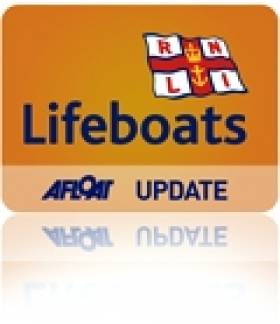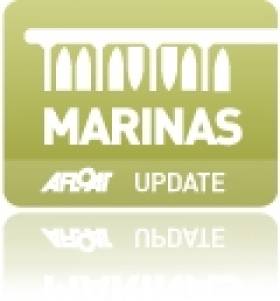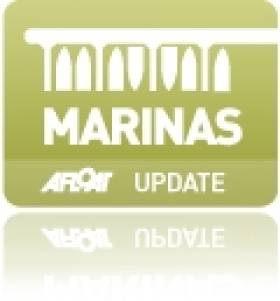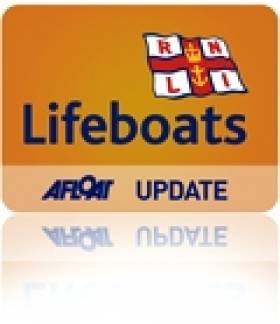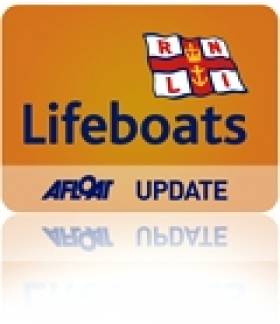Displaying items by tag: Kilrush
The Duke of Kent visited Kilrush RNLI yesterday afternoon as part of a two-day tour of lifeboat stations in Tipperary, Clare and Kerry. The Duke has been President of the RNLI since 1969.
The Duke of Kent arrived at Kilrush Lifeboat Station shortly after 03:00pm, where His Royal Highness was greeted by the volunteer lifeboat operations team, lifeboat crew members and the local fundraising branch.
As part of the visit, Kilrush RNLI showcased local Irish dancing, the Irish Whale & Dolphin Group, handcrafted traditional Irish Currach building, and a selection of local pottery from the Brothers of Charity. Also, in attendance were representatives from Kilrush GAA which focused on the partnership between the GAA and RNLI working together to prevent drowning.
To conclude, a beautiful Irish Yew tree was planted at Kilrush lifeboat station to honour the visit, followed by a brief launch and recovery of Kilrush RNLI’s Atlantic 85 lifeboat.
Commenting on the event, Pauline Dunleavy, Kilrush Lifeboat Operations Manager said: ‘It was an honour to welcome His Royal Highness to Kilrush lifeboat station. We are very proud of our station delighted to host the President of the RNLI. We showcased our great team, as well as great community spirit. In particular, I would like to thank Kilrush GAA for attending. Much like a lifeboat station, a GAA club is at the heart of community life, and through this partnership we all can both play a major role in preventing deaths by drowning.”
Class two yacht Ibaraki skippered by John Collins from Galway Bay Sailing Club has been declared overall winner of the 2016 WIORA Championships after a six race series at Kilrush Marina on the Shannon Estuary. Download results below.
Collins continued his overall lead into the final two races on Sunday, emerging a clear winner with a four point margin. The modified GK34 beat Liam Burke's Corby 25 Tribal on 13.5 points with Ray McGibney's Dehler 34 Disaray from Foynes Yacht Club third on 15 points.
In class one at the Royal Western Yacht Club of Ireland event, Yannick Lemonnier's Galway Flyer, an SJ320, from Galway Bay Sailing Club, beat the First 36.7, 2 IRL1514 Zallaq (Duncan & Emmet Kerin) from the host club in a five–boat fleet.
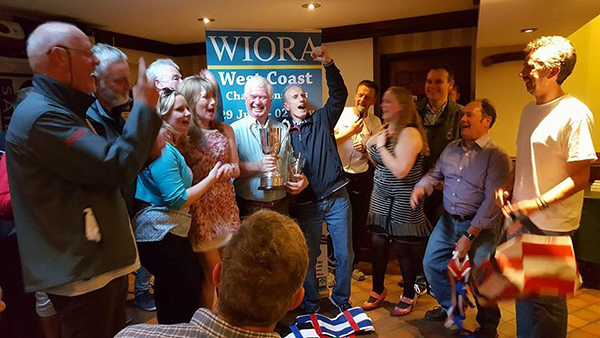
The WIORA prizegiving at the Haven, Kilrush with John Collins's Ibaraki crew lifting the overall trophy. Photo: WIORA/Facebook
In a five boat class three made up entirely of J24s, Darragh McCormack's Maximus from Foynes Yacht Club was the overall winner. Simon McGibney's Carpe Diem was second ahead of third placed Jibe sailed by Fergus Kelliher of Tralee Bay Sailing Club.
In a white sails fleet of 13 boats, the overall winner was Tom Murray's Kerry Sloop, Kerry Dream, with Pat Keating on Excalibur in second. James McCormack on Alpara finished in third place. The top three were all from Foynes Yacht Club.
30–boats competed in three classes in the 40th anniversary of the event.
Additional reporting by Elaine O'Mahoney, WIORA:
The event took place over four days in heavy winds which even in the ‘lulls’ hardly dropped below 15 knots.
Looking ahead at the forecast the race officers made the decision to have three races on day one as a contingency in case any of the subsequent days were blown out. The IRC racing on day one was windward leeward courses west of Scattery Island where OOD Alan Crosbie and his team did a fantastic job in shifty conditions requiring moving of marks between legs to keep the beats true. Winds of about 25 knots and strong tides were a certainly challenge with some of the bigger boats reefed down and the smaller boats all with jibs but the general consensus of the competitors was hugely enjoyable racing.
It was decided to have the longer coastal race on day two which had the IRC classes beat about six miles west in the estuary towards Carrigaholt. Trusting the weather forecast the OOD handed out the race course to all competitors prior to leaving the Kilrush Marina. As the start time approached the first ‘beat’ was looking more like a ‘fetch’ but as if Alan Crobie flicked a switch just as he sounded the first warning signal the wind backed about 25 degrees to make the first beat a proper one. And for anyone not familiar with sailing in tidal waters, one boat commented afterwards it took them nearly two hours to beat to the windward mark and twenty five minutes to get back. Welcome to sailing in tides! The contingency decision made earlier paid off as Friday saw winds of between 35 and 40 knots blow though. The shelter provided in the recently refurbished, and I must say looking smashing, Kilrush Marina was much appreciated by all the boat owners.
The final day of racing winds brought winds gusting up to 30 knots and wind shifts of 30 degrees to contend with and the race organisers did very well to get in a final two races which brought a discard into play for all competitors.
Across all the classes racing was hugely competitive. In the six race series the most races won by any of the overall winners was three races, which was Yannick Lemonnier’s Galway Flyer in Class One while Emmet & Duncan Kerin’s First 36.7, Zallaq came in 2nd and 3rd place went to Liam Madden’s X332 Dexterity.
In Class Two, the eventual overall champions, John Collins’ GK34, Ibariki had two wins out of six claiming the class ahead of last years’ winner Liam Burke’s Corby 25 Tribal with the Dehler 34 Dis-a-Ray under the new helm of Fionn McGibney finishing 3rd.
In class three, an all J24 affair, there was nothing between the fleet who, no matter what tactics employed or what side of the course taken, seemed to converge together at every single mark! At the end of the first day the top three boats were level on points. With just one win throughout the series it was the consistency of Darragh McCormack’s J, Maximus, which kept them at the top. 2nd and 3rd place, who both had two wins each, finished level on points but on countback Martin McNamara on Carpe Diem took 2nd ahead of Fergus Kelliher on Jibe in 3rd.
In what has been hailed by the White Sails fleet as a huge success, WIORA for the first time brought in a second OOD, Peter Moore from Tralee Bay Sailing Club, to officiate the White Sails racing. The 13 boat fleet stayed further east along the estuary between Scattery Island and Tarbert. While at the pre-race briefing the competitors spoke of White Sails ‘going out to have fun’ nothing could be further from the truth once the first gun was sounded. The courses were Round The Cans and competition was fierce with the series leader changing many times throughout the four day event. In the end the experience of the Foynes Yacht Club boats in sailing in the strong tidal waters came through as first, second and third places all went to the Shannon Estuary based club. Tom Murray’s Kerry Sloop, Kerry Dream, was relishing the heavy weather taking first place overall with Pat Keating on Excalibur, competing in his first West Coast Championships on his Westerly Fulmar, but with a few crafty and well-seasoned sailors on board came in second. James McCormack’s Dufour 35 Alpara, finished in third place. The two White Sails boats that came down from the lake thanked the West of Ireland Offshore Racing Association and the Irish Cruiser Racing Association for their generosity in helping them get lifted and transported down for the event due to the lower River Shannon being closed at Ardnacrusha.
WIORA Commodore, Simon McGibney congratulated Adrian O’Connell and the members of The Royal Western Yacht Club of Ireland and Thomas Whelan, Chairperson of the Organising Committee for hosting what was widely agreed was a fantastic event. He also thanked the OOD’s Alan Crosbie and Peter Moore and their teams for exceptional racing in testing conditions and finally thanked Kilrush Credit Union, Kilrush Marina and all the other sponsors of the event.
Overall Winners:
Class One IRC :
Galway Flyer (Jannick Lemonnier, Galway Bay Sailing Club)
Class One ECHO:
Dexterity (Liam Madden, Foynes Yacht Club)
Class Two IRC:
Ibaraki (John Collins, Galway Bay Sailing Club)
Class Two ECHO:
Ibaraki (John Collins, Galway Bay Sailing Club)
Class Three IRC:
Maximus (Darragh McCormack, Foynes Yacht Club)
Class Three ECHO:
Carpe Diem (Martin McNamara, Foynes Yacht Club)
White Sails:
Kerry Dream (Tom Murray, Foynes Yacht Club)
Full Results can be found below.
Belfast Lough Celebrates 150 Years of Organised Sailing in Style
The development of organised sailing in Ireland seems to have spread northeastwards from the south and southwest coasts. Although the great chieftain Hugh Maguire had a fleet of pleasure vessels including sailing craft on Lough Erne in County Fermanagh in the 1500s, while the noted scientific polymath Sir William Petty found a sailing “pleasure boatte” on Dublin Bay to test his catamaran Simon & Jude against in 1663, it was on Cork Harbour that we find the first formal organisation with the foundation of the Water Club in 1720 writes W M Nixon.
Before the advent of good roads, and long before the railways arrived, Ireland’s myriad waterways and lakes provided the best options for the inland transport both of goods and people, and inevitably some gentrifried working boats were also used for relaxation, and the next club to be formed was Lough Ree YC in 1770. By 1820, the world’s first club specifically organised to provide racing came into being on Lough Erne, then nearby on Lough Gill in Sligo, the Ladies’ Cup was first raced for in 1822, and it still is cometed for today, though now at Sligo YC’s sea base at Rosses Point.
In the pre-famine era before 1845, the relative affluence of the west and southwest of Ireland supported the landed classes in yacht ownership, and a regatta at Kilrush in the Shannon Estuary in 1828 saw the establishment of the Royal Western of Ireland YC, which at its height in 1838 had a fine fleet of 18 cutters – some of quite substantial size - based in Kilrush Creek and spreading outwards to families along the coast such as the O’Connells of Tralee, Cahirsiveen and Derrynane.
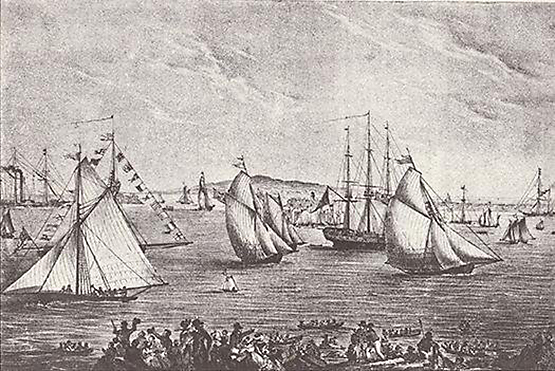
The Game Changer. Dun Laoghaire’s first regatta in 1828 set Dublin Bay on course to be the pace-setter in yachting development.
But 1828 also saw the first regatta to be staged at the new harbour of Kingstown on Dublin Bay, and the success of this provided an unrivalled focus for the development of new ideas in sailing not only in Ireland, but at an international level. Whereas other sailing area saw the locations of activity spread across several centres large and small, in Dublin Bay there was just this one big powerhouse of sailing development through which all the recreational nautical energy of the capital city was channeled. The Royal Irish YC came into being in 1831, the Royal St George YC got going in 1838, and soon Kingstown outstripped most comparable centres at home and abroad, particularly in racing development.
Yet at this time Belfast was already the fastest-expanding city in Ireland, and it was moreover a growing centre of genuine wealth-creating manufacturing industries and ship-building enterprises. Why wasn’t Belfast Lough in the forefront of sailing development by the 1850s?
It wasn’t as though there wasn’t a small but time-honoured local recreational sailing tradition on Belfast Lough. During the 1780s and 1790s, Belfast had been a place of liberal ideas and social innovation, and a small group of recreational sailors led by Henry Joy McCracken pioneered cruising from Belfast Lough to the west coast of Scotland and the Hebrides. But then in 1798 McCracken also led the rising of the United Irishmen, and when it was suppressed he was executed by hanging in the Cornmarket in Belfast on land which his grandfather had donated to the town.
Subsequently, the Presbyterian majority in the north turned in on themselves and concentrated on commerce and manufacture and literally minding their own business. But though, as prosperity returned, a small group of McCracken’s former shipmates formed the Northern Yacht Club in Belfast Lough in 1824, Belfast’s rapid industrial expansion made the port very limited as a yacht harbour, thereby limiting their growth.
Belfast Lough may have provided splendid sailing water, but it was very poorly served by other smaller harbours, so the Northern Yacht Club members often found themselves sailing to the more congenial and well-serviced shores of the Firth of Clyde. They soon formed a Scottish branch, and by 1838 the Royal Northern Yacht Club - as it was to become, with an impressive clubhouse in Rothesay - had taken over the few remaining assets of the Belfast Lough branch, and that was the end of any club in the Lough for another quarter century.
Yet any student of sailing history will know that in 1856, Lord Dufferin from Clandeboye near Bangor on the shores of Belfast Lough made a celebrated voyage to the high Arctic with his schooner Foam. And in 1865, one of the most successful racing schooners of all time, the 99ft Egeria, was built for leading Belfast linen manufacturing magnate John Mulholland. So why wasn’t Belfast Lough sharing the sailing fame of other Irish centres such as Dublin Bay and Cork Harbour, which had shown their pre-eminence by staging the world’s first recognisably modern offshore race from Dublin Bay to Cork Harbour in 1860?
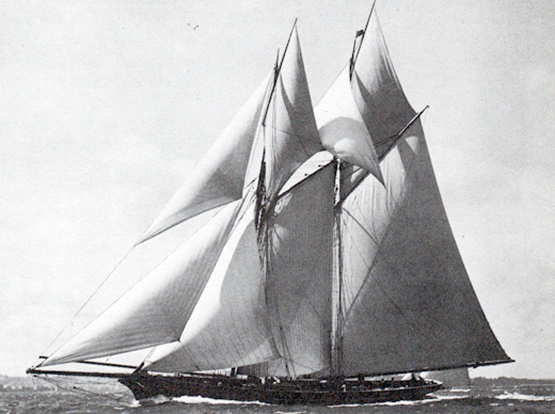
The extremely successful racing schooner Egeria was built for Belfast business magnate John Mulholland in 1865, but she was seldom if ever in Belfast Lough
The simple answer seems to be that in its period of hyper-growth, the business of Belfast was business, and sailing for recreation was not a Belfast business. Those who expected to sail at the highest level did so elsewhere, and once the Belfast to Dublin railway had been connected in 1855, it was as handy for the more affluent would-be yachtsmen to avail of the proper facilities in Dublin Bay rather than risk their yachts on exposed moorings in Belfast Lough, where shore facilities were still woefully lacking.
But in time the rapid rise of an energetic middle class in Belfast saw increasing demand for sailing amenities and events nearer home. We know that a regatta of some sort was staged at Holywood immediately east of Belfast on the lough’s south shore in 1854, and it was at Holywood – despite the little town’s drying anchorage – that the first club since the Northern YC in 1824, the Hoywood Yacht Club – was formed in 1862, and it still exists, Belfast Lough’s senior club.
Then in 1866 a regatta was staged from the only half decent harbour on the lough, at Carrickfergus, and the organisers were pleasantly surprised by the number of boats which turned out, boats whose owners had squirrelled out bits of shelter for their craft in small places like Donaghadee, Groomsport, the tiny drying harbour at Bangor, in the open roadstead off Cultra, in the cleaner parts of Belfast docks, in Carrickfergus itself, and round the corner in Larne Lough.
From this there immediately emerged the Carrickfergus Amateur Rowing & Sailing Club, but mostly to cater for local demand. But soon afterwards in Belfast the Ulster Yacht Club was formed by a group of affluent businessmen, professionals, industrialists and landowners with Lord Dufferin as their Commodore. By 1869 he’d seen to it that they’d become the Royal Ulster Yacht Club, but it was an organisation which was resolutely to function without a clubhouse until 1899, nevertheless growing in prestige with every passing year.
Thanks to that focus of interest through the Carrickfergus Regatta of 1866, 2016 will see double celebrations on Belfast Lough with the 150th Anniversaries of both Carrickfergus Amateur Rowing and Sailing Club (which everyone knows as Carrick Sailing Club), and the Royal Ulster Yacht Club, which since April 1899 has been based in an impressive Arts & Crafts clubhouse on an eminence above Bangor’s waterfront.
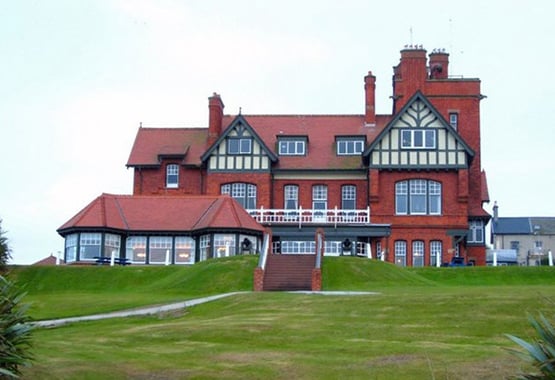
The RUYC clubhouse was built in 18 months and opened in 1899 in order to be ready for Thomas Lipton’s first America’s Cup campaign
When the clubhouse was built, the harbour at Bangor was still rudimentary, but the sailing was great. However, since 1984 Bangor Bay has been turned into one of Ireland’s largest marinas, and now RUYC has the berthing facilities and the sailing water to stage major events with confidence.
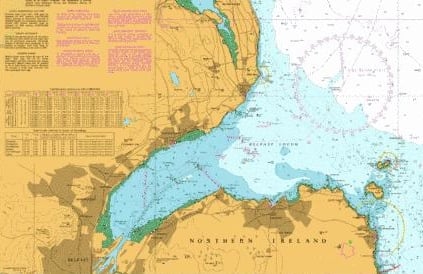
Befast Lough provides excellent sailing water, but until the marina were built at Carrickfergus and Bangor, it lacked sheltered berthing
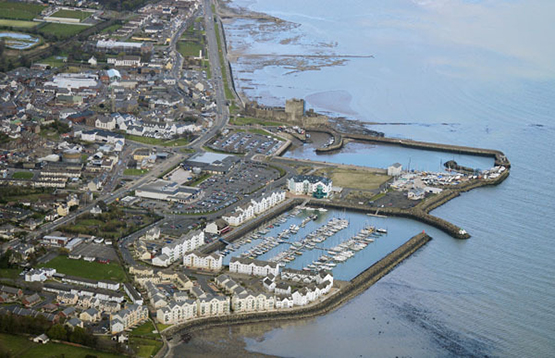
Carrickfergus Marina, with the harbour and its famous 12th Century castle beyond
Equally at Carrickfergus they also have a marina – in fact it pre-dates the one at Bangor – but as Carrickfergus was also the base of the extraordinarily productive yachtbuilder John Hilditch, albeit only from 1889 to 1913, one of the main parts of their celebration is going to be a Hilditch Regatta, not just for boats built by him such as Hal Sisk’s famous 1894 Watson cutter Peggy Bawn, the Howth 17s of 1898, and the RNIYC Fairy Class of 1901, but indeed for any classic or traditional craft, as Carrick has always been a spiritual home for the Old Gaffers Association.
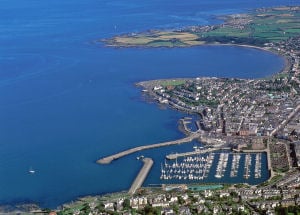
Bangor Marina, with Ballyholme Bay beyond
Royal Ulster has meanwhile taken a different track through sailing history, for between 1899 and 1931, it was the club through which Thomas Lipton made his five America’s Cup Challenges, which has tended to obscure the fact that in the 1880s and 1890s, Belfast Lough with RUYC in a key role were setting a fantastic pace in sailing development, as they were trying to get a one design keelboat class going as long ago as 1889, and by 1895 they’d brought the Belfast Lough One Design Association into being with a determined young sailing man called James Craig as Honorary Secretary. Membership of the BLODA was open to any member of one of the recognised six clubs now based round the lough, but young Craig – who later went on to become Lord Craigavon, first Prime Minister of Northern Ireland in 1921 – was realistic in his expectations for the life of a strict one design keelboat class, and he only expected his members to be “in class” for three seasons.
By 1896 they’d the first two boats of a new 15ft LWL keelboat class designed by William Fife, no less, sailing on Belfast Lough, and before the summer was out the signs were good for a significant increase in numbers for 1897. James Craig was insisting the boats be built by John Hilditch, as he was noted for sticking strictly to the plans as drawn by the designer, whereas the builder of the first two boats for 1896, Paddy McKeown in the heart of Belfast, was always trying to improve on the designs, even if they were from Fife.
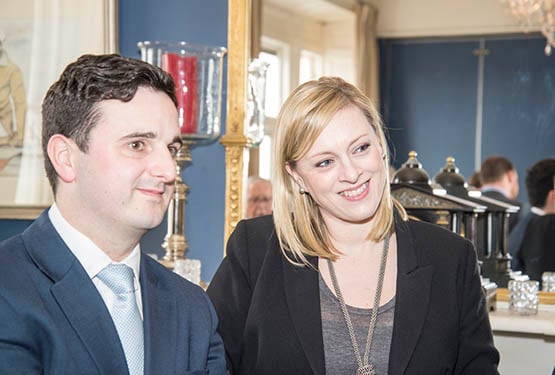
Regatta day for the Dublin Bay 25s – their design was inspired by the Befast Lough Class I boats.
But events overtook the programme. A group of affluent Belfast Lough movers and shakers decided they certainly wanted a One-Design class to the Belfast Lough ODA rules and designed by William Fife, but they wanted a proper sea-going boats with a cabin, around 37ft in hull overall length, and 25ft on the waterline, and setting a proper gaff rig with a jackard topsail rather than the modest little gunter rig set by the 15ft LWL boats, which were still referred to as Class I.
But as the idea for the bigger boats gained traction, they became Class I, and for a while the 15ft LWL boats became Class II, but after 1900 they were Class III when a 20ft LWL class came along. But meanwhile in late 1896 and early 1897, the Hilditch yard went mad, building nine of the new 25ft LWL boats. Even Lord Dufferin and his friends Lord de Ros and Lord Bangor came round from County Down in April 1897 to the tough town of Carrickfergus to see this remarkable new class of boats being built. And once the 25 footer had their first race off Carrickfergus on May 29th , they swung into action with what today would be called a series of promotional tours, as they did all of Clyde Fortnight after a stormy crossing of the North Channel, and then after being back in Belfast Lough for long enough to race the RUYC regatta, they headed south to Dublin Bay in late July and inspired the creation of the Dublin Bay 25 class.
1898 was when they were in their prime, and by 1899 some owners were aready invoking the “three season” rule to move on, but in fact the class continued to race actively – though sometimes with very depleted numbers – on Belfast Lough until the end of the 1909 season.
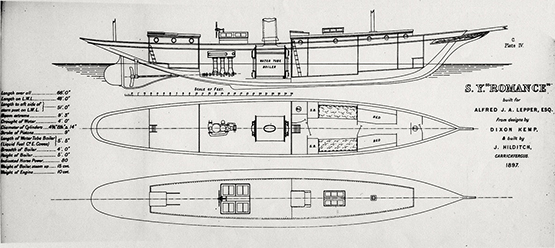
John Hilditch was very busy in 1897 – in addition to the Belfast Lough Class I boats, his yard also built this 56ft motoryacht Romance for A J Lepper, for whom he’d built Peggy Bawn in 1894.
We get some idea of the boat-building pace around Carrickfergus in the late 1890s when we realise that in 1897 John Hilditch and his men were also building a 57ft Dixon Kemp motor-yacht, the Romance, for A J Lepper, for whom they’d built Peggy Bawn so well in 1894, and no sooner was the Romance out of the way than they turned to the next job, the building of the first five Howth 17s which their owners were able to sail the 90 miles to their home port in April 1898.
So obviously there’s going to be quite a complicated programme around Belfast Lough in late June and early July this year. And as the Howth 17s are in the unique position of being a Hilditch class which is not Belfast Lough-based, they hope to be able to pay their respects at Carickfergus both to the memory of their builder and to the 150th Anniversary of the Carrickfergus club, while also being able to do full justice to the Classic One Designs Regatta, which RUYC will be staging from Friday June 24th to Sunday June 26th.
The Hilditch Regatta meanwhile is from the evening of Wednesday June 22nd to Saturday June 23rd, when the fleet heads from Carrickferus to Bangor for a sail-past as part of the Royal Ulster events, but with some of the Old Gaffers then returning to Carrick (after due celebrations in Bangor) as the Carrick event is seen partially as a follow-on to the Portaferry Sails & Sounds the previous weekend, which is very much an Old Gaffers event.
In Carrickfergus are (left to right) Nick Massey, Roddy Cooper, Tom Houlihan, CSC Commodore Wendy Moore, and Ian Malcolm. Photo: W M Nixon
But for classes like the Howth 17s, despite their antiquity proper racing is what it’s all about, so I tagged along with a reconnaissance group of Howth 17 eminences when they went up North to suss out the scene this week. And as the group included Nick Massey who re-energised the class when it was going through a flakey period in 1972, Ian Malcolm who is playing a key role in the class’s current revival such that they’ll have eighteen boats racing this year, Roddy Cooper who owns the Hilditch-built Leila, and Class Captain Dr Tom Houlihan, you can be quite sure there wasn’t a dull moment.
First call was with Wendy Moore at Carrickfergus, where she’s Commodore for the 150th as the club settle into the new clubhouse after a disastrous fire three years ago, and as she’s also the Marina/Boatyard Manager and the newest addition to the ranks of owners in the local thriving Ruffian 23 class, everyone was on the same wavelength.
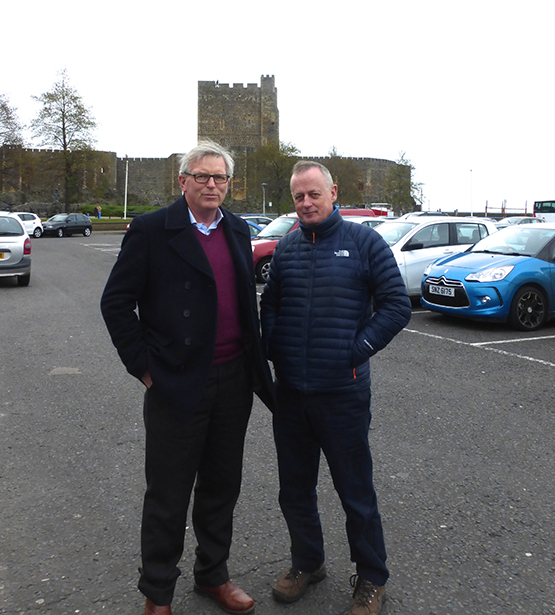
You’ll always find it’s now in a carpark….Roddy Cooper and Ian Malcolm stand on the spot where their Howth 17s Leila and Aura were built in 1898, with Carrickfergus Castle in the background. Photo: W M Nixon
Then we swung by Royal North of Ireland Yacht Club at Cultra on the south shore of the lough, home to the Hilditch-built Fairy class against whom the Howth crowd regularly have inter-club races, and fortuitously met up with Northern Ireland Old Gaffers Association Chairman Gary Lyons for some very high-powered info exchange. As a result we round out this week’s blog with a photo which does justice to the Portaferry Sails & Sounds which he is organising in June.
Then on in haste for a sailing business lunch (delicious) at Royal Ulster YC with Vice Commodore Myles Lindsay, Rear Commodore Greg Taylor, Honorary Sailing Secretary Robin McKelvey and Press Officer Fiona Hicks, learning yet again that the RUYC clubhouse is such a store of sailing memorabilia that it’s a difffcult to concentrate on the formal agenda, but I think the Howth men and the Bangor men understood each other very well indeed.

Myles Lindsay, Vice Commodore RUYC

Robin McKelvey, Honorary Sailing Secretary RUYC
The RUYC people have a lot on their plate, for no sooner is the Classics Regatta out of the way than they gear up at the beginning of July for an assembly in Bangor of cruising boats from the ICC, the RCC, the OCC, the CCC and other associated organisations, followed by a 150th Anniversary Cruise-in-Company along the Antrim coast and on to the West Coast of Scotland and the Hebrides.
But for the recce group from Howth, now it was down to Bangor Marina where manager Kevin Baird couldn’t have been more obliging, but the Howth 17 men all fell in love with the classic ketch Morna berthed right next to the marina office, so Fiona and I had to speed them on their way to the exhibition of 150 Years of sailing in Bangor Museum.
The classic ketch Morna in Bangor Marina. Photo: W M Nixon
And then after that, duty done and work completed, I took them for the treat of the day, down among the hidden places of Strangford Lough to meet up with Kenny Smyth at his boatyard, which for any one who is into classic, vintage or traditional boats is heaven on earth. And of course it emerged that Kenny the King of the River Class, Whiterock’s historic Mylne-designed premier fleet, has recently become Commodore of Strangford Lough Yacht Club. So we headed for home into a gorgeous sunset having notched up two Commodores, one Vice Commodore, one Rear Commodore, one Chairman, one Honorary Sailing Secretary, two Marina Managers and one Press Officer. And if that’s not a good day’s work on the diplomacy and negotiating front, then I don’t know what is.
The eternal enthusiast. Kenny Smyth of Whiterock runs a boatyard, he is also Commodore of Strangford Lough Yacht Club, he is River Class champion, and he just loves talking about boats night and day. Photo: W M Nixon
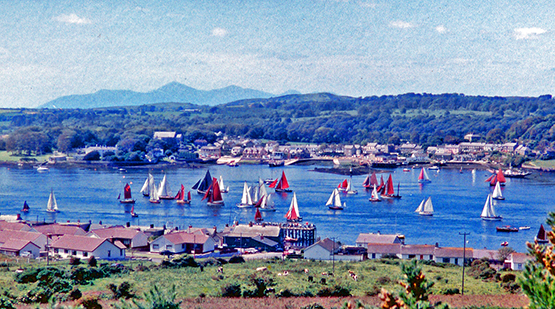
The promise of summer – the classic and traditional season in the north starts with Portaferry Sails and Sounds on June 16th.
Kilrush RNLI Launch in Gales to Assist 43ft Motor Vessel
Kilrush RNLI Lifeboat crew on the Shannon Estuary launched early this morning in gale force conditions to assist 43ft motor vessel that had fouled its propeller south of Moneypoint.
At 4.59am Shannon Coast Guard tasked Kilrush RNLI volunteer lifeboat crew to assist a motor vessel with 3 people on board that had lost engine power due to its propeller becoming fouled.
Kilrush lifeboat crew reached the scene at 5.20am and assessed the situation. It was apparent that the motor vessel was heavily fouled and in no immediate danger of drifting. Commercial divers were tasked as the sea state improved and managed to clear the propeller. Kilrush RNLI stood by until power was restored to the motor vessel and returned to station at 7.10am.
Commenting on the callout, Charlie Glynn, Kilrush RNLI Lifeboat Press Officer said: ‘Weather conditions were challenging but our volunteer crews are well prepared for every eventuality. This is a testament to the level of training and commitment from all at Kilrush RNLI.’
#kilrushmarina – Kilrush Marina recently celebrated 12 months under new ownership having carried out an extensive upgrade and modernisation to the facilities costing in excess of €1m.
As Afloat.ie reported back in March, Kilrush Marina was taken over in July 2014 from the semi state company Shannon Development who oversaw the construction of the 120 berth marina in 1991. Included in the work was the overhaul of the lock gates which included shotblasting and painting, structural repairs, new seals and an automated system to make them 24 hr accessible.
The pontoon electrics were replaced, an automated 24hr fuel system was installed,wi fi accessible on all pontoons. Security was upgraded with comprehensive CCTV and automated gates on both pontoons and boatyard. The Marina Centre building was refurbished, and new showers installed in the changing rooms, the Marina entrance and car parks were landscaped and tarmacked.
In the boatyard, the drainage was redone,shed roofs repaired and a 16 ton hydraulic boat trailer purchased to compliment the existing 45t–travel hoist.
The final job was dredging the access channel, which because its in a Special Area of Conservation took a lot of time and effort to get permission.
However its finally done and provision is now in place for annual maintenance dredging.
Kilrush Marina is the only full service marina on the west coast offering a full range of boatyard and berthing options and is easily accessible from both Shannon Airport 45 minutes away and the motorway network 30 minutes away.
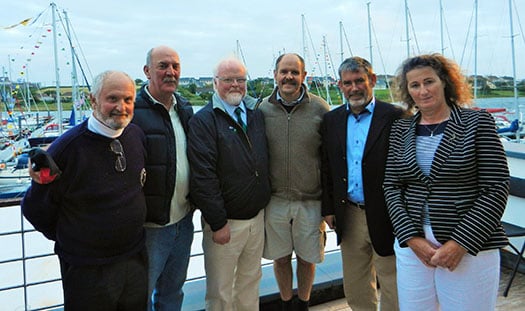
(L to R) Adrian O'Connell, Commodore Royal Western YCI , James Mc Cormack Commodore, Foynes YC, Pierce Purcell, Irish Sailing Association, Richard Hurley, Commmodore Tralee Bay SC, Louis Keating Managing Director L&M Keating, Kim Roberts, Kilrush Marina Manager.
Kilrush RNLI Lifeboat In Multi-Agency Search Operation
#lifeboat – Lifeboat crew launched early this morning to take part in a multi agency search and rescue operation involving Kilrush and Fenit RNLI, Coast Guard rescue teams from Kilkee and Doolin.
At 3.29am Shannon Coast guard tasked Kilrush RNLI volunteer lifeboat crew to investigate a report of four persons in the water in the Poulnasherry Bay area of the Shannon Estuary.
Kilrush lifeboat crew were met by members of the public on the scene who had successfully recovered three persons safely from the water. The casualties were transferred by ambulance to Limerick Regional Hospital. Kilrush RNLI, Kilkee Coast Guard and the Shannon based Coast Guard helicopter undertook a large-scale search of the area to locate a fourth missing person.
The search operation continued through the night with the addition of Fenit RNLI lifeboat, Doolin Coast Guard, Irish Customs Vessel, Ballybunnion Rescue Services, SFPC Pilot Boat as well as an extensive shore search team from all agencies as well as navy diving units.
A person was recovered from the water at 10.42am following an extensive search.
Commenting on the callout, Pauline Dunleavy, Kilrush RNLI Lifeboat Operations Manager said: 'This was one of the largest search and rescue operation in the Shannon Estuary for a number of years. I would like to commend the quick response from all agencies especially the members of the public that assisted. On behalf of everyone at Kilrush RNLI Lifeboat Station, I wish to express our sincere condolences to the family and friends of the man who sadly did not survive.
Portmagee Marina Pontoons Set For Second Season in County Kerry
#irishmarinas – Portmagee Marina pontoons are set for a second season of operation, built by L&M Keating Ltd, for Kerry Co Council, the 20–berth facility was opened in 2014 in the pretty port of Portmagee.
It is operated by Kilrush Marina who also operate the 120–berth County Clare facility. Most of the berths are occupied by the fleet of Skellig passenger boats that operate from Portmagee, however there are a number of berths reserved for visitors which have proved to be a very popular overnight stop off for cruising yachts during 2014.
Portmagee offers a 'traditional Kerry welcome' and the marina is situated 50m from the village main street and across the road from the popular Moorings Bar and Restaurant run by Gerard Kennedy who manages the marina. Gerard can be contacted on 087 2390010 for anyone wishing to book a berth.
#kilrushmarina – Work on lock gates at Kilrush marina on the Shannon Estuary was completed in March, just in time for the first sail of the year over St Patricks weekend.
The 120 berth Kilrush Marina has recently been undergoing an exciting upgrade and modernisation under the new ownership of L&M Keating, Building and Civil Engineering contractors based in Kilmihill, Co Clare.
Kilrush Marina was taken over by operating company L&M Keating (Maritime) Ltd in July 2014, since when a one million euro investment has been taking place at this strategically important marina that stands at the mouth of the Shannon Estuary and the start of the Shannon system.
Under manager Kim Roberts the massive upgrade, which is almost finished, has marked the revival of the Marina to compliment the town of Kilrush, winner of the 2014 Tidy Towns gold medal award. Among the major work carried out was the renovation of the lock gates which necessitated the closure for 8 weeks in January and February. The gates are being currently automated so 24 hr access will shortly be available, the dredging on the channel is due to begin within weeks which will return the channel to 2.5 m below LAT.
Also at Kilrush, one of only three marinas on the west coast, the pontoon berths have been rewired and the pontoons repaired, a new floating breakwater is constructed and due to be installed shortly which will offer additional protection to an already well sheltered and safe marina.
A self service state of the art diesel system has been fitted in the marina with 24hr opening and which is operated using debit or credit cards. In the boatyard the marina haspurchased a 15-ton hydraulic trailer to compliment the 45-ton travel hoist, so Kilrush Marina can now offer indoor storage in addition to the extensive existing boatyard out door storage.
The Marina Centre has been modernised and upgraded with the approach roads and car parking re done along with landscaping to give a very attractive visual aspect to the town of Kilrush. Other facilities added include Wi Fi to all pontoon berths.
It has been a very exciting time for all our customers who can look forward to using the newly enhanced facilities and enjoying the high levels of customer service Kilrush Marina are now proud to offer.
Kilrush RNLI Lifeboat on Standby Following Aircraft 'Pan-Pan' Radio Call
#lifeboat – Kilrush RNLI on the Shannon Estuary was put on standby yesterday following a Pan-Pan urgency on board a small aircraft while on approach to Shannon airport.
An alert was received from Valentia Coast Guard yesterday afternoon at 3.06pm (Sunday 1 February) following a report that a small aircraft with six people on board had issued a Pan-Pan radio call as it approached Shannon Airport. It is understood the plane was experiencing fuel difficulties.
The volunteer crew assembled within minutes and prepared their inshore lifeboat for standby.
At 3.46pm, the plane made a safe landing at Shannon Airport. The Coast Guard requested the lifeboat and the crew to stand down.
Commenting on the call out, Pauline Dunleavy, Kilrush RNLI Lifeboat Operations Manager said: 'I would like to commend our crew for their quick response this afternoon in getting to the station and preparing the lifeboat for launch. Thankfully the aircraft was able to make a safe landing today.'
Plane 'Cargo Hold Fire Alert' Leads to Kilrush Lifeboat Call Out
#rnli – An early morning airline alert for Kilrush RNLI lifeboat gave its new Lifeboat Operations Manager her first callout in charge.
Newly appointed Lifeboat Operations Manager (LOM) at Kilrush RNLI, Pauline Dunleavy, had her first callout in charge of the Clare lifeboat station on the Shannon Estuary, when an alert was received early this morning (14 December 2014) and the lifeboat was launched to reports that a plane flying overhead had observed an indication that a fire may have broken out in the cargo hold.
In these circumstances it is standard procedure to launch the lifeboat and it gave Pauline a chance to see how fast the lifeboat can be launched and the response of the volunteers in times of emergency. Pauline was a helm at the lifeboat station before she stood down recently to take up the role of Lifeboat Operations Manager from the outgoing one, John Lambe.
The lifeboat was launched at 9.20am and kept a presence on the river before they learned that the flight, which was en route to France, had landed safely at Shannon airport and they were stood down.
Commenting on the callout Kilrush RNLI Lifeboat Operations Manager Pauline Dunleavy said, 'During my first callout in this new role, it was great to see the lifeboat crew respond to an emergency from the other side. I had the opportunity to see the work the lifeboat crew do and it showed me that with their ongoing training, our volunteers are ready for anything.'
'Thankfully in this instance we were stood down and everyone was safe but it does give us an opportunity to test our responses and to be ready to launch to anything. I know this role is a hugely important one at a lifeboat station and I look forward to working with everyone involved in Kilrush RNLI.'





























